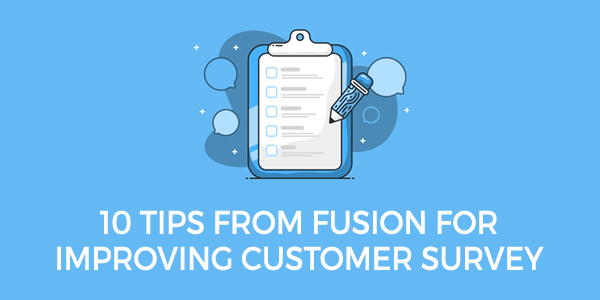While a customer survey is a useful way to gather a large volume of data in a very short span of time, creating a useful customer survey is not an easy task. Companies must be careful while creating a customer survey. You can also ask your call center service provider for help creating the perfect survey. Having experience conducting numerous surveys, call center service providers possess a deep understanding of what a successful customer survey should look like and can help you create such surveys and see them succeed. Fusion CX has a set of ten rules for creating the perfect customer survey. These 10 easy tips for improving customer surveys have helped several businesses achieve their desired results. What to know about them? Read on:
10 Tips for Improving Customer Surveys
1. Keep it Short
A short survey is often a successful one. Your survey should be clear and concise. You must find the shortest way to ask questions that get you the total answer. Eliminate superfluous phrasing, reduce the character count, and try everything you can to keep it short. A short survey often has the lowest abandon rate. After all, no one wants to answer a questionnaire for 30 minutes or more.
2. Ask questions with a purpose only
Don’t hesitate to remove unnecessary questions from your surveys. Every question must have a clear purpose and a good reason to be there. If not, chuck it out. If you can monitor the channel through which the customer came to your site, do not hesitate to remove it from the survey. These questions make the survey lengthy and cause customers to abandon it.
3. Create open-ended questions
Sure, multiple-choice questions look tempting, but to get insightful feedback, open-ended questions are your best bet. It will allow you to know what your customers are really thinking. But do not ask questions that may come with a big, lengthy answer. It’s best to take on brief questions first to create a sense of progress and then give your customers the opportunity to elaborate on their thoughts.
Fusion CX plans a simple introduction and follows up the answer with an open-ended question such as, “Why is that so?”
4. One question at a time
Bombarding your customer with so many questions at once is never a good idea and yet we see it in many such surveys. It feels like being interrogated by someone who won’t want to listen to you. For quality responses, your customers need time to think and you have to give them that. If you keep asking multiple questions at one go, you will get half-hearted answers because at that point your customer is just looking for a way to get to the end.
5. Make scales consistent
We often encounter surveys with confusing usage of common scales under a different context.
For example – initially, you are to rate an experience between 1-5, with 1 being “Poor” and 5 being “excellent”. Later in the survey, you are to evaluate the importance of certain things, with 1 being the most important and 5 being less important.
This is utterly confusing to a customer. A customer may completely miss the change and give an inaccurate answer to the same.
![]()
6. Avoid loaded questions
Do not ask questions with a bias in their phrasing that may lead respondents towards a particular answer. It will not get you the result you are looking for. Clip the language that can influence a respondent’s thinking into answering in a certain way.
For example, “What do you think of our award-winning popular children’s book series?” is not the best way to ask survey questions. You will get a far honest answer if you ask, “What do you think about our children’s book series?”
While the first question in the example will earn you supporters who tell you what you want to hear, the second question will get you closer to the real scenario. So, if you want to get a real picture, stir clear of those adjectives and specialties unless absolutely necessary.
7. Use Yes/No questions
If a question can be answered in yes/no, try to frame it that way. Close-ended questions make great starter questions for a survey, as they are easier to evaluate and complete.
8. Avoid assumptions
If you create questions assuming all customers know something, you will have problems. Check your language and terminology and avoid industry jargon, references, and acronyms.
Rather, you can ask customers for their opinions on one subject and ask them to be specific. This will get you a far better response.
9. Timing matters
Time is crucial in a customer survey. In most cases, companies conduct customer surveys once per quarter. But waiting that long to know the customer’s pulse does not seem enough. You must conduct small but potent surveys regularly to get the real picture. Alternatively, you can gather the idea by looking at customer satisfaction ratings and other metrics.
10. Entice them with a bonus
Enticing the customers with an incentive can increase the participation rate. It can be a discount, account credit, or a giveaway. One may think that incentives may influence the quality of responses, but this is likely not the case. Also, see whether you can financially handle the incentive and then proceed.
These are the ten tips that Fusion CX follows to improve customer surveys for its clients. Numerous clients benefitted from our deep insight into the customer survey domain.

